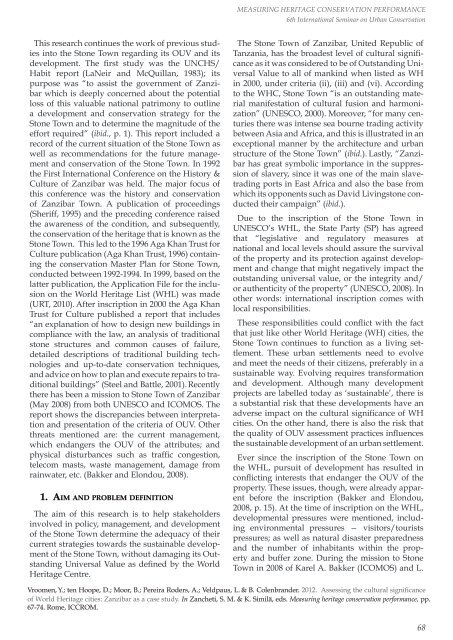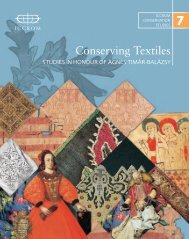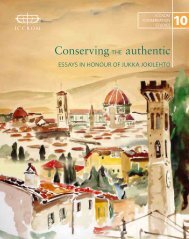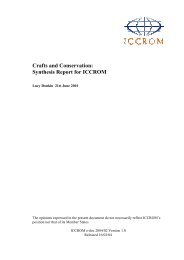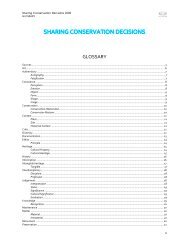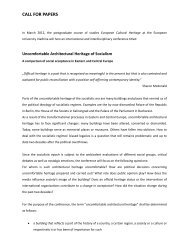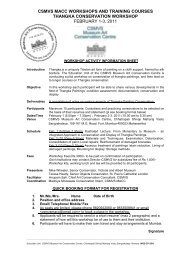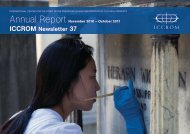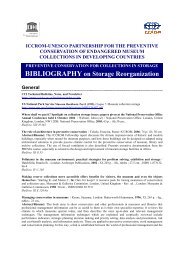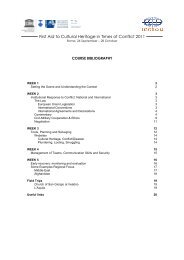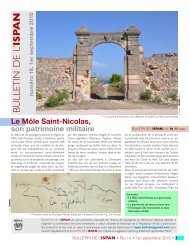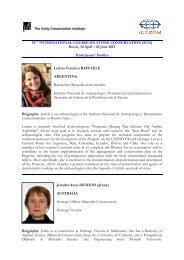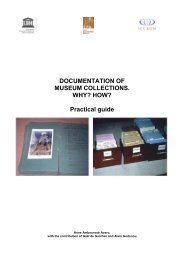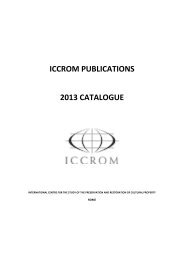part 1 - Iccrom
part 1 - Iccrom
part 1 - Iccrom
You also want an ePaper? Increase the reach of your titles
YUMPU automatically turns print PDFs into web optimized ePapers that Google loves.
MEASURING HERITAGE CONSERVATION PERFORMANCE<br />
6th International Seminar on Urban Conservation<br />
This research continues the work of previous studies<br />
into the Stone Town regarding its OUV and its<br />
development. The first study was the UNCHS/<br />
Habit report (LaNeir and McQuillan, 1983); its<br />
purpose was “to assist the government of Zanzibar<br />
which is deeply concerned about the potential<br />
loss of this valuable national patrimony to outline<br />
a development and conservation strategy for the<br />
Stone Town and to determine the magnitude of the<br />
effort required” (ibid., p. 1). This report included a<br />
record of the current situation of the Stone Town as<br />
well as recommendations for the future management<br />
and conservation of the Stone Town. In 1992<br />
the First International Conference on the History &<br />
Culture of Zanzibar was held. The major focus of<br />
this conference was the history and conservation<br />
of Zanzibar Town. A publication of proceedings<br />
(Sheriff, 1995) and the preceding conference raised<br />
the awareness of the condition, and subsequently,<br />
the conservation of the heritage that is known as the<br />
Stone Town. This led to the 1996 Aga Khan Trust for<br />
Culture publication (Aga Khan Trust, 1996) containing<br />
the conservation Master Plan for Stone Town,<br />
conducted between 1992-1994. In 1999, based on the<br />
latter publication, the Application File for the inclusion<br />
on the World Heritage List (WHL) was made<br />
(URT, 2010). After inscription in 2000 the Aga Khan<br />
Trust for Culture published a report that includes<br />
“an explanation of how to design new buildings in<br />
compliance with the law, an analysis of traditional<br />
stone structures and common causes of failure,<br />
detailed descriptions of traditional building technologies<br />
and up-to-date conservation techniques,<br />
and advice on how to plan and execute repairs to traditional<br />
buildings” (Steel and Battle, 2001). Recently<br />
there has been a mission to Stone Town of Zanzibar<br />
(May 2008) from both UNESCO and ICOMOS. The<br />
report shows the discrepancies between interpretation<br />
and presentation of the criteria of OUV. Other<br />
threats mentioned are: the current management,<br />
which endangers the OUV of the attributes; and<br />
physical disturbances such as traffic congestion,<br />
telecom masts, waste management, damage from<br />
rainwater, etc. (Bakker and Elondou, 2008).<br />
1. Aim and problem definition<br />
The aim of this research is to help stakeholders<br />
involved in policy, management, and development<br />
of the Stone Town determine the adequacy of their<br />
current strategies towards the sustainable development<br />
of the Stone Town, without damaging its Outstanding<br />
Universal Value as defined by the World<br />
Heritage Centre.<br />
The Stone Town of Zanzibar, United Republic of<br />
Tanzania, has the broadest level of cultural significance<br />
as it was considered to be of Outstanding Universal<br />
Value to all of mankind when listed as WH<br />
in 2000, under criteria (ii), (iii) and (vi). According<br />
to the WHC, Stone Town “is an outstanding material<br />
manifestation of cultural fusion and harmonization”<br />
(UNESCO, 2000). Moreover, “for many centuries<br />
there was intense sea bourne trading activity<br />
between Asia and Africa, and this is illustrated in an<br />
exceptional manner by the architecture and urban<br />
structure of the Stone Town” (ibid.). Lastly, “Zanzibar<br />
has great symbolic importance in the suppression<br />
of slavery, since it was one of the main slavetrading<br />
ports in East Africa and also the base from<br />
which its opponents such as David Livingstone conducted<br />
their campaign” (ibid.).<br />
Due to the inscription of the Stone Town in<br />
UNESCO’s WHL, the State Party (SP) has agreed<br />
that “legislative and regulatory measures at<br />
national and local levels should assure the survival<br />
of the property and its protection against development<br />
and change that might negatively impact the<br />
outstanding universal value, or the integrity and/<br />
or authenticity of the property” (UNESCO, 2008). In<br />
other words: international inscription comes with<br />
local responsibilities.<br />
These responsibilities could conflict with the fact<br />
that just like other World Heritage (WH) cities, the<br />
Stone Town continues to function as a living settlement.<br />
These urban settlements need to evolve<br />
and meet the needs of their citizens, preferably in a<br />
sustainable way. Evolving requires transformation<br />
and development. Although many development<br />
projects are labelled today as ‘sustainable’, there is<br />
a substantial risk that these developments have an<br />
adverse impact on the cultural significance of WH<br />
cities. On the other hand, there is also the risk that<br />
the quality of OUV assessment practices influences<br />
the sustainable development of an urban settlement.<br />
Ever since the inscription of the Stone Town on<br />
the WHL, pursuit of development has resulted in<br />
conflicting interests that endanger the OUV of the<br />
property. These issues, though, were already apparent<br />
before the inscription (Bakker and Elondou,<br />
2008, p. 15). At the time of inscription on the WHL,<br />
developmental pressures were mentioned, including<br />
environmental pressures — visitors/tourists<br />
pressures; as well as natural disaster preparedness<br />
and the number of inhabitants within the property<br />
and buffer zone. During the mission to Stone<br />
Town in 2008 of Karel A. Bakker (ICOMOS) and L.<br />
Vroomen, Y.; ten Hoope, D.; Moor, B.; Pereira Roders, A.; Veldpaus, L.·& B. Colenbrander. 2012. Assessing the cultural significance<br />
of World Heritage cities: Zanzibar as a case study. In Zancheti, S. M. & K. Similä, eds. Measuring heritage conservation performance, pp.<br />
67-74. Rome, ICCROM.<br />
68


